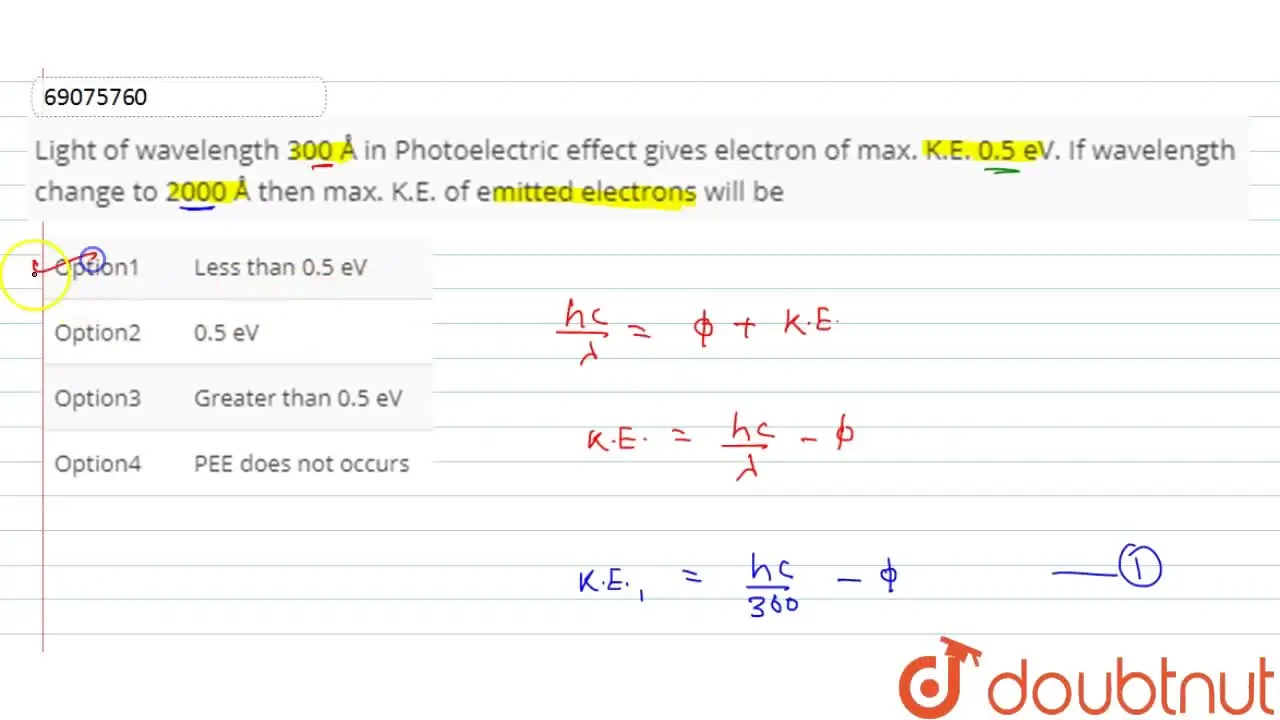Light of wavelength 300 Å in Photoelectric effect gives electron of max. K.E. 0.5 eV. If wavelength change to 2000 Å then max. K.E. of emitted electrons will be
Less than 0.5 eV
0.5 eV
Greater than 0.5 eV
PEE does not occurs
The correct Answer is:A
Then K.E. will be greater than 0.5 eV
Related Playlists
- BOOK - NEET PREVIOUS YEAR (YEARWISE + CHAPTERWISE)CHAPTER - NEETEXERCISE - PHYSICS157videos
NEET
- BOOK - NEET PREVIOUS YEAR (YEARWISE + CHAPTERWISE)CHAPTER - NEETEXERCISE - QUESTION95videos
NEET
- BOOK - NEET PREVIOUS YEAR (YEARWISE + CHAPTERWISE)CHAPTER - MOTION IN TWO AND THREE DIMENSIONEXERCISE - All Questions47videos
MOTION IN TWO AND THREE DIMENSION
- BOOK - NEET PREVIOUS YEAR (YEARWISE + CHAPTERWISE)CHAPTER - NEET 2020EXERCISE - All Questions45videos
NEET 2020
Similar Questions
In a photoelectric experiment, with light of wavelength λ , the fastest electron has speed v. If the exciting wavelength is changed to 5λ4 , the speed of the fastest emitted electron will become
View SolutionIf the de broglie wavelength of an electron is 1Å, then the velocity of the electron will be
View SolutionWork function of a metal surface is ϕ=1.5eV. If a light of wavelength 5000Å falls on it then the maximum K.E. of ejected electron will be-
View SolutionThe study of diffraction of electrons from a target, gives the wavelength associated as 0.65Å. The energy of the electrons will be
View SolutionIn a photoelectric effect experiment the threshold wavelength of light is 380 nm. If the wavelength of incident light is 260 nm, the maximum kinetic energy of emitted electrons will be ________eV
Given E (in eV) = 1237λ(in mm)View SolutionThe work function of a metal is 2.5 eV. Light of wavelength 3600 Å is incident on this metal surface. The velocity of emitted photoelectrons will be
View SolutionThreshold wavelength for photoelectric effect on sodium is 5000Å . Its work function is
View SolutionThe work function of metal is 1eV. Light of wavelength 3000Å is incident on this metal surface . The velocity of emitted photo - electrons will be
View SolutionFor light of a wavelength 4000 Å, the photon energy is 2eV. For X rays of wavelength 1 Å, the photon energy will be
View SolutionLight of waelength 4000Å is incident on a metal plate with work function 2eV. The max. K.E. of the photoelectrons is
View Solution


